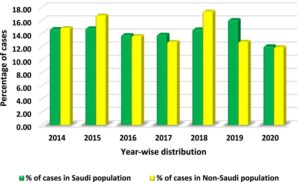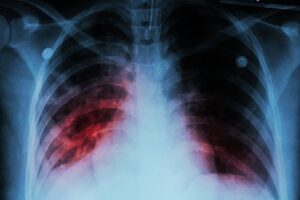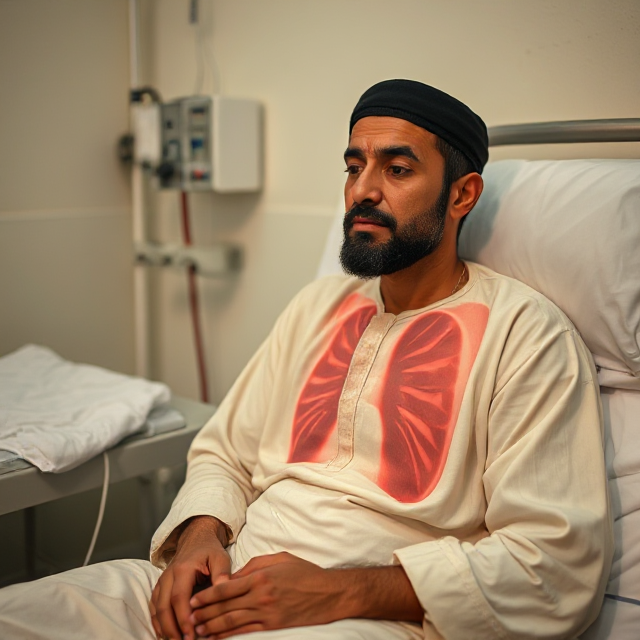Authored by: Humza Rana
Tuberculosis presents a worldwide health issue due to its ability to spread. The Kingdom of Saudi Arabia (KSA) confronts a challenge with the transmission of tuberculosis through migrant laborers, but the most significant risk comes from the vast number of pilgrims journeying to the holy sites of the Islamic world in the sacred cities of Makkah and Al Medina. Pilgrims arrive throughout the year, particularly during the months of Ramadan and Zul-Hijah. The emergence of resistance in Mycobacterium tuberculosis is a recognized global trend that positions these large gatherings as potential hotspots for the spread and transmission of the disease on an international scale. Despite the existence of very strict and effective measures, the threat persists due to the constantly evolving nature of this highly virulent disease. This summary primarily underscores the current public health obstacles posed by this illness to the Saudi medical system, which needs to be brought to the attention of not only the relevant authorities in KSA but also to concerned global entities, as pilgrims and migrants originate from all corners of the globe, with a significant number hailing from countries heavily burdened by tuberculosis.

Tuberculosis is an ailment triggered by germs known as bacteria, which predominantly target the lungs. You can contract TB by inhaling these germs. Those with a compromised immune system face an elevated risk of contracting TB. Such a system can be impaired due to an inadequate diet, diseases, medications, or other factors.
Indicators
There are two types of TB infection: latent and active. Latent infection occurs when you might show no symptoms of TB. The bacteria are present in your body, but remain dormant. Active TB manifests when individuals exhibit symptoms associated with the bacteria, such as:
• A cough persisting beyond three weeks or one that refuses to subside
• Elevated temperature
• Unintended weight loss or diminished appetite
• A general sense of weakness and fatigue
• Pain in the chest
• Sweating during the night
Diagnosis
A skin examination will be conducted to determine if you are infected. A positive result indicates that infection has occurred. If your result is affirmative, your physician might also perform a blood evaluation, a chest X-ray, and sputum analyses to confirm the presence of TB. Family members and others residing with you will similarly undergo skin testing. A negative result often suggests an absence of infection. The skin test might not yield a reaction if your immune system is weak. Your physician may investigate further for TB if your skin test is negative, yet you still display symptoms.

Barriers to Tuberculosis Control in Arab Nations
Stigma and Cultural Beliefs: In many Arab countries, TB is still associated with stigma, which deters individuals from seeking timely diagnosis and treatment. The perception that TB is a disease linked to poverty, neglect, or poor hygiene creates a reluctance to discuss or acknowledge symptoms. This social stigma, combined with a lack of awareness, prevents early detection, contributing to the spread of the disease.
Limited Access to Healthcare: Access to healthcare varies significantly across the Arab world, especially in rural or conflict-affected regions. In some areas, there is a shortage of health facilities, medical professionals, and diagnostic tools, which delays detection and treatment. Additionally, the absence of adequate healthcare infrastructure and funding for TB programs further exacerbates the issue.
Migrant Populations and Pilgrimage Risks: Arab nations, particularly Saudi Arabia, experience high levels of migration, both for work and religious purposes. Migrant laborers often come from countries with a high burden of TB, leading to an increased risk of transmission. Furthermore, the annual influx of pilgrims to Makkah and Madinah creates large gatherings that can act as hotspots for the spread of the disease. Effective screening and vaccination efforts are often strained by the transient nature of these populations.
Drug Resistance
The emergence of drug-resistant TB (DR-TB) is a growing concern across the Arab region. Ineffective or incomplete treatment regimens, along with the misuse of antibiotics, have contributed to the rise of multi-drug-resistant (MDR) and extensively drug-resistant TB (XDR-TB). This complicates treatment protocols and prolongs the infectious period, increasing the strain on health systems.
Strategies for Addressing Tuberculosis in Arab Nations
Strengthening Public Awareness Campaigns: Raising public awareness about the symptoms of TB, its modes of transmission, and the importance of early diagnosis is crucial. Public health campaigns should focus on dispelling myths and reducing stigma associated with the disease. Community engagement, especially through social media, local health centers, and religious leaders, can play an important role in encouraging individuals to seek medical help when needed.
Improved Healthcare Access and Infrastructure: Governments must prioritize investments in healthcare infrastructure, particularly in rural and underserved areas. Mobile health units, telemedicine, and other innovative healthcare delivery models can enhance access to TB diagnosis and treatment. Additionally, increasing the number of trained healthcare professionals, including community health workers, is essential for more effective TB management.
Targeted Screening and Vaccination: In countries with large numbers of migrant workers and pilgrims, implementing targeted TB screening and vaccination programs is essential. For example, Saudi Arabia has established screening protocols for pilgrims before they enter the holy sites, but similar strategies need to be replicated in other regions. Routine screening for high-risk populations, such as healthcare workers, prisoners, and refugees, is also crucial for early detection.
Strengthening TB Treatment Programs: Adopting a patient-centered approach to TB treatment can improve outcomes. This involves providing support for individuals undergoing treatment, ensuring adherence to drug regimens, and addressing the mental health needs of TB patients. Integrating TB treatment with other healthcare services, such as HIV care and maternal health, can reduce the burden on patients and improve their overall health outcomes.
Collaborating on Research and Drug Development: Regional collaboration in TB research can lead to the development of new diagnostic tools, vaccines, and treatment options tailored to the unique challenges of the Arab world. By participating in global TB research initiatives and investing in local scientific communities, Arab countries can contribute to the development of more effective solutions to combat TB and drug resistance.

Barriers to Tackling Tuberculosis in Arab Nations
Tuberculosis (TB) remains a significant health challenge in many Arab nations, primarily due to several barriers that hinder effective control and prevention. One major obstacle is the stigma and discrimination associated with TB, which often prevents individuals from seeking diagnosis or treatment out of fear of social rejection. Additionally, there is a general lack of awareness about TB in certain regions, especially in rural areas, where people may not fully understand the causes, symptoms, or preventive measures of the disease. Inadequate healthcare infrastructure also plays a crucial role, as limited resources, both in terms of medical facilities and trained personnel, hinder the timely diagnosis and treatment of TB. Furthermore, ongoing political and economic instability in some Arab countries disrupts healthcare systems, exacerbating the situation, especially in conflict zones or refugee camps where overcrowded living conditions make populations more susceptible to TB.
Cultural and Religious Beliefs also contribute to the barriers, as some individuals may prefer traditional medicine over seeking modern medical care, or they may hesitate to seek treatment due to misconceptions about the disease. Additionally, drug-resistant strains of TB are becoming an increasing challenge, complicating treatment efforts and requiring advanced diagnostic tools and second-line medications, which may not always be available in resource-limited settings.
Strategies to Overcome Barriers
To address these barriers, comprehensive strategies are needed. Public awareness campaigns through media, schools, and community leaders can help reduce stigma and educate the public about TB’s symptoms, transmission, and the importance of completing treatment. Expanding healthcare access, particularly in rural or underserved areas, can be achieved through mobile clinics, telemedicine, and investments in healthcare infrastructure. Moreover, training healthcare professionals to recognize and treat TB effectively is critical to ensuring prompt diagnosis and appropriate care. Strengthening national TB programs and introducing measures such as directly observed treatment short-course (DOTS) can improve treatment adherence. Tackling drug-resistant TB requires the introduction of advanced diagnostic tools and second-line therapies, along with enhanced surveillance of drug resistance patterns. Finally, engaging community and religious leaders to promote TB awareness and encourage early treatment can help overcome cultural barriers. By implementing these strategies, Arab nations can significantly improve TB control and move closer to eliminating the disease.
Conclusion
Tuberculosis continues to pose a significant public health challenge in Arab nations, with several barriers impeding the effective control and elimination of the disease. However, by addressing these barriers through a combination of public awareness, improved healthcare access, targeted screening, and innovative treatment strategies, Arab countries can make meaningful progress in reducing TB rates. Collaborative efforts across the region, along with continued investment in healthcare systems and research, are essential to ensuring that TB no longer remains a threat to public health in the Arab World.
Sources
2. Tuberculosis Diagnostic Market
